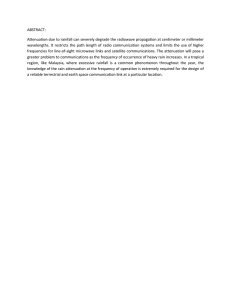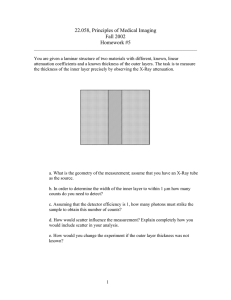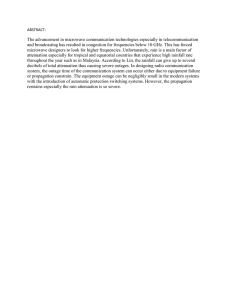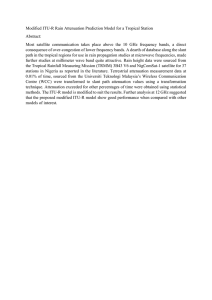Michael Baumer: Skin Depth and Attenuation on the Anode Card
advertisement
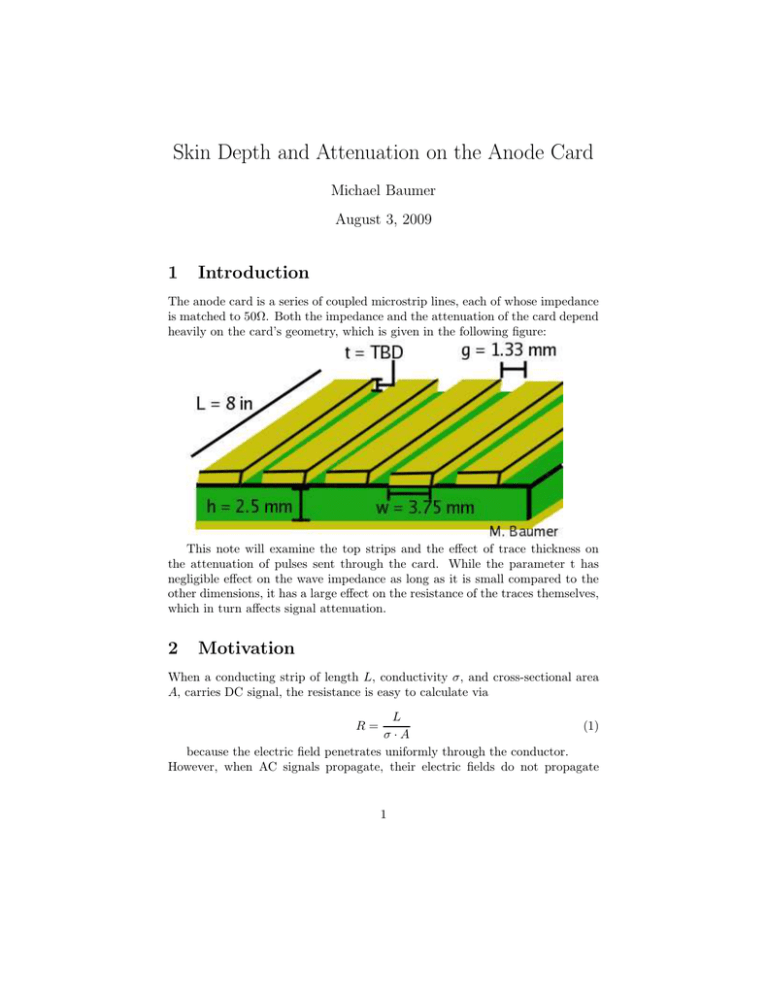
Skin Depth and Attenuation on the Anode Card Michael Baumer August 3, 2009 1 Introduction The anode card is a series of coupled microstrip lines, each of whose impedance is matched to 50Ω. Both the impedance and the attenuation of the card depend heavily on the card’s geometry, which is given in the following figure: This note will examine the top strips and the effect of trace thickness on the attenuation of pulses sent through the card. While the parameter t has negligible effect on the wave impedance as long as it is small compared to the other dimensions, it has a large effect on the resistance of the traces themselves, which in turn affects signal attenuation. 2 Motivation When a conducting strip of length L, conductivity σ, and cross-sectional area A, carries DC signal, the resistance is easy to calculate via L (1) σ·A because the electric field penetrates uniformly through the conductor. However, when AC signals propagate, their electric fields do not propagate R= 1 uniformly throughout the conductor, due to a phenomenon known as the skin effect. For AC signals, the electric field (and the current density by Ohm’s Law) is given as a function of depth by E(z) = E0 · e−z/δ (2) where r 2 (3) σµω and µ is the magnetic permeability and ω is the signal frequency in radians. For example, the skin depth of copper at 3.5GHz (σ = 60 × 106 S/m and µ = 4π × 10−7 H/m) is 1.1 µm. The following figure shows the difference between the electric fields of AC and DC signals in conductors with finite conductivity. The green line represents DC field penetration as a function of depth, while the blue exponential curve represents AC field penetration. The red vertical line represents an arbitrary conductor boundary, as might be used as a limit of integration when determining AC resistance from skin depth . δ= E,J Harb. unitsL 1.2 1.0 0.8 0.6 0.4 0.2 0 3 5. ´ 10-7 1. ´ 10-6 1.5 ´ 10-6 2. ´ 10-6 z HmL 2.5 ´ 10-6 Simulation and Results The following chart was calculated using MATLAB. This chart displays the AC resistance of a silver trace on top of the anode substrate in Ω for an eight inch card at the given trace thickness and bandwidth. BW \ Thickness 1GHz 2GHz 3GHz 3.5GHz 4GHz 5GHz 1 µm 3.1692 3.4735 3.7181 3.8278 3.9316 4.1252 2 µm 1.9658 2.3163 2.6047 2.7356 2.8599 3.0929 2 3 µm 1.5950 1.9858 2.3092 2.4558 2.5948 2.8545 4 µm 1.4299 1.8537 2.2024 2.3594 2.5077 2.7829 5 µm 1.3447 1.7940 2.1597 2.3230 2.4765 2.7598 Compare these values of AC resistance to the DC resistances of the same traces, calculated formula (1): Thickness RDC 1 µm 2.5046 2 µm 1.2523 3 µm 0.8349 4 µm 0.6262 5 µm 0.5009 These numbers are important because they affect the amount of attenuation suffered by a pulse traveling down the transmission line. Using SPICE to simulate pulses of current traveling in the entire length of the line, the following data were obtained: Bandwidth 1GHz 1GHz 1GHz 3.5GHz 3.5GHz 3.5GHz 4 Trace Thickness 1 µm 2 µm 3 µm 1 µm 2 µm 3 µm Attenuation/8in 9% 9% 8% 19% 18% 18% dB/8in -.82 -.82 -.72 -1.83 -1.72 -1.72 Conclusion For operation at 3.5 GHz, there is little to be gained from going beyond 2 µm of trace thickness. Additional silver would decrease the resistance by a fraction of an ohm, but at 2 µm, the resistance of one trace is 2.74 Ω, which is already small compared to 50 Ω. Because of this, the attenuation due to the effective voltage divider is small; most of the attenuation comes from inductance and capacitance, parameters essentially fixed by the geometry. For this reason, small variations in the trace resistances have little effect on the overall behavior of the line. This is corroborated by the results of a SPICE simulation with all resistance removed, which shows that even when the trace is assumed to have infinite conductivity, the signal is still attenuated 16%. This shows that only 2-3% of the attenuation seen in the SPICE model is due to resistive losses; the rest of the attenuation is due to low-pass filtering (due to line geometry). As an aside, it should be noted that a 3.5GHz pulse traveling from the center of a card with 2µm traces to the edge (half the length) only suffers 11% attenuation. 5 Other Losses According to microwaves101.com, RF transmission line losses can be traced to four different sources: αC = loss due to trace resistance αD = loss due to tan(δ) α= αG = loss due to substrate conductivity (G 6= 0) αR = radiative loss 3 αC was analyzed in this note. We now consider the other possible sources of signal attenuation. αG is caused by the fact that, in practice, no dielectric has σ = 0 or equivalently ρ = ∞. According to the same website, these losses can be ignored when ρ > 105 Ω · cm. For Pyrex 7740, ρ = 8 × 1010 Ω · cm. We can therefore safely ignore dielectric conduction losses. αR is essentially thermal loss. When the detector is functioning properly, these losses will likely be unavoidable but negligible. αD is loss caused by the friction experienced by the molecules of the dielectric as they rapidly rotate to align themselves with the alternating electric field. These losses are proportional to a factor represented by tan(δ), which is derived from the complex permittivity of the dielectric. E.B. Shand’s Glass Engineering Handbook gives a plot of 7740’s loss tangent vs. signal frequency: The loss due to this effect can be calculated by: ωC 0 Z0 (dB/meter) (4) 2 where C 0 is the line’s capacitance per meter. Shand’s plot gives tan(δ) = .006, so αD = 3.1 dB per meter, which is equivalent to .634 dB for the entire card, which means approximately 7% attenuation for a pulse traveling the entire length of the card. This loss may have a considerable effect and must be analyzed further. αD = 8.686 · tan(δ) · 4
